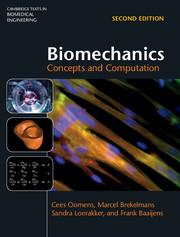Book contents
- Frontmatter
- Contents
- About the Cover
- Preface to the First Edition
- Preface to the Second Edition
- 1 Vector and Tensor Calculus
- 2 The Concepts of Force and Moment
- 3 Static Equilibrium
- 4 The Mechanical Behaviour of Fibres
- 5 Fibres: Time-Dependent Behaviour
- 6 Analysis of a One-Dimensional Continuous Elastic Medium
- 7 Biological Materials and Continuum Mechanics
- 8 Stress in Three-Dimensional Continuous Media
- 9 Motion: Time as an Extra Dimension
- 10 Deformation and Rotation, Deformation Rate and Spin
- 11 Local Balance of Mass, Momentum and Energy
- 12 Constitutive Modelling of Solids and Fluids
- 13 Solution Strategies for Solid and Fluid Mechanics Problems
- 14 Solution of the One-Dimensional Diffusion Equation by Means of the Finite Element Method
- 15 Solution of the One-Dimensional Convection–Diffusion Equation by Means of the Finite Element Method
- 16 Solution of the Three-Dimensional Convection–Diffusion Equation by Means of the Finite Element Method
- 17 Shape Functions and Numerical Integration
- 18 Infinitesimal Strain Elasticity Problems
- References
- Index
7 - Biological Materials and Continuum Mechanics
Published online by Cambridge University Press: 02 February 2018
- Frontmatter
- Contents
- About the Cover
- Preface to the First Edition
- Preface to the Second Edition
- 1 Vector and Tensor Calculus
- 2 The Concepts of Force and Moment
- 3 Static Equilibrium
- 4 The Mechanical Behaviour of Fibres
- 5 Fibres: Time-Dependent Behaviour
- 6 Analysis of a One-Dimensional Continuous Elastic Medium
- 7 Biological Materials and Continuum Mechanics
- 8 Stress in Three-Dimensional Continuous Media
- 9 Motion: Time as an Extra Dimension
- 10 Deformation and Rotation, Deformation Rate and Spin
- 11 Local Balance of Mass, Momentum and Energy
- 12 Constitutive Modelling of Solids and Fluids
- 13 Solution Strategies for Solid and Fluid Mechanics Problems
- 14 Solution of the One-Dimensional Diffusion Equation by Means of the Finite Element Method
- 15 Solution of the One-Dimensional Convection–Diffusion Equation by Means of the Finite Element Method
- 16 Solution of the Three-Dimensional Convection–Diffusion Equation by Means of the Finite Element Method
- 17 Shape Functions and Numerical Integration
- 18 Infinitesimal Strain Elasticity Problems
- References
- Index
Summary
Introduction
Up to this point, all treated problems have been in some way one-dimensional. In Chapter 3 we have discussed equilibrium of two- and three-dimensional bodies and in Chapter 4 the fibres were allowed to have some arbitrary orientation in three-dimensional space. But, when deformations were involved, the focus was on fibres and bars, dealing with one-dimensional force–strain relationships. Only one-dimensional equations were solved. In this chapter and the ones that follow, the theory will be extended to the description of three-dimensional bodies, and it is opportune to spend some time looking at the concept of a continuum.
Consider a certain amount of solid and/or fluid material in a three-dimensional space. Although in reality for neighbouring points in space the (physical) character and behaviour of the residing material may be completely different (because of discontinuities at the microscopic level, which become clearer on reducing the scale of observation), it is common practice that a less detailed description (at a macroscopic level) with a more gradual change of physical properties is used. The discontinuous heterogeneous reality is homogenized and modelled as a continuum. To make this clearer, consider the bone in Fig. 7.1. Although one might conceive the bone at a macroscopic level, as depicted in Fig. 7.1(a), as a massive structure filling all the volume that it occupies in space, it is clear from Fig. 7.1(b) that at a smaller scale the bone is a discrete structure with open spaces in between (although the spaces can be filled with a softer material or a liquid). At an even smaller scale, at the level of one single trabecula, individual cells can be recognized. This phenomenon is typical for biological materials at any scale, whether it is at the organ level, the tissue level or cellular level, or even smaller. At each level, a very complex structure can be observed, and it is not feasible to take into account every detail of this structure. That is why a homogenization of the structure is necessary, and, depending on the objectives of the modelling (which is the question that has to be answered in the context of the selection of the theoretical model), a certain level of homogenization is chosen.
- Type
- Chapter
- Information
- BiomechanicsConcepts and Computation, pp. 133 - 154Publisher: Cambridge University PressPrint publication year: 2018



